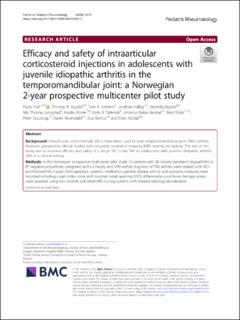Efficacy and safety of intraarticular corticosteroid injections in adolescents with juvenile idiopathic arthritis in the temporomandibular joint: a Norwegian 2-year prospective multicenter pilot study
Frid, Paula; Augdal, Thomas Angell; Larheim, Tore Arne; Halbig, Josefine Mareile; Rypdal, Veronika Gjertsen; Songstad, Nils Thomas; Rosén, Annika; Tylleskär, Karin; Berstad, Johanna Elisabeth Rykke; Flatø, Berit; Stoustrup, Peter; Rosendahl, Karen; Kirkhus, Eva Astrid; Nordal, Ellen Berit
Journal article, Peer reviewed
Published version

Åpne
Permanent lenke
https://hdl.handle.net/11250/2738007Utgivelsesdato
2020Metadata
Vis full innførselSamlinger
Sammendrag
Background
Intraarticular corticosteroids (IACs) have been used to treat temporomandibular joint (TMJ) arthritis. However, prospective clinical studies with magnetic resonance imaging (MRI) scoring are lacking. The aim of this study was to examine efficacy and safety of a single IAC in the TMJ in adolescents with juvenile idiopathic arthritis (JIA) in a clinical setting.
Methods
In this Norwegian prospective multicenter pilot study 15 patients with JIA (mostly persistent oligoarthritis or RF negative polyarthritis categories) and a clinically and MRI-verified diagnosis of TMJ arthritis were treated with IACs and followed for 2 years. Demographics, systemic medication, general disease activity and outcome measures were recorded including a pain-index score and maximal incisal opening (MIO). Inflammation and bone damage scores were assessed, using two recently published MRI scoring systems with masked radiological evaluation.
Results
Among the 15 patients, 13 received a single IAC (5 bilateral), and 2 repeated IACs once unilaterally. Thus, the total number of IACs was 22. Median age was 15 years and the majority had an age not thought of as critical regarding mandibular growth retardation due to steroid injection. During the 2-year observation period systemic medication with disease modifying antirheumatic drugs (DMARDs) including biologics was initiated or adjusted in 10/15 (67%) patients. At the 2-months study visit after injection we observed a minimal improvement in MIO from median 44 (1st, 3rd quartiles; 36, 48) mm to 45 (43, 47) mm, p = 0.045 and decreased MRI mean additive inflammatory score from 4.4 ± 1.8 standard deviations (SD) to 3.4 ± 2.0, p = 0.040. From baseline to the 2-months follow-up pain improved in 6/11 patients but pain scores were not significantly improved. MRI-assessed damage increased in two patients with repeated IACs, and decreased in 3 patients but most of the patients were stable over the 2-year follow-up. Intra-rater repeatability of the MRI scoring system domains varied from poor to excellent.
Conclusions
In this pilot study of predominately single IACs to the TMJ in combination with systemic treatment we observed improvement in MRI-assessed inflammation, mostly stable condylar bone conditions and minimal clinical improvement in adolescents with JIA and TMJ arthritis. No severe side effects were seen.
